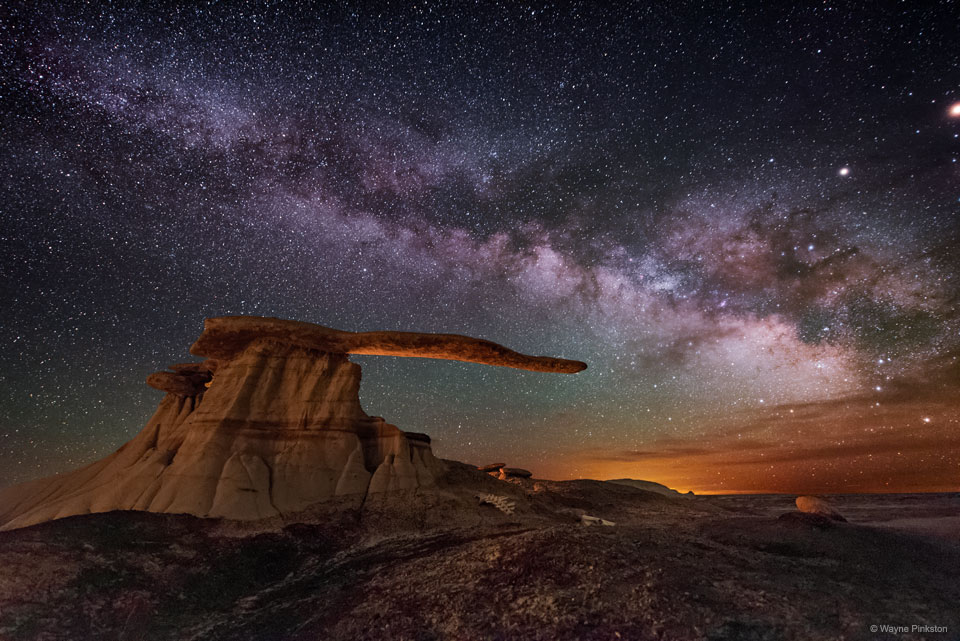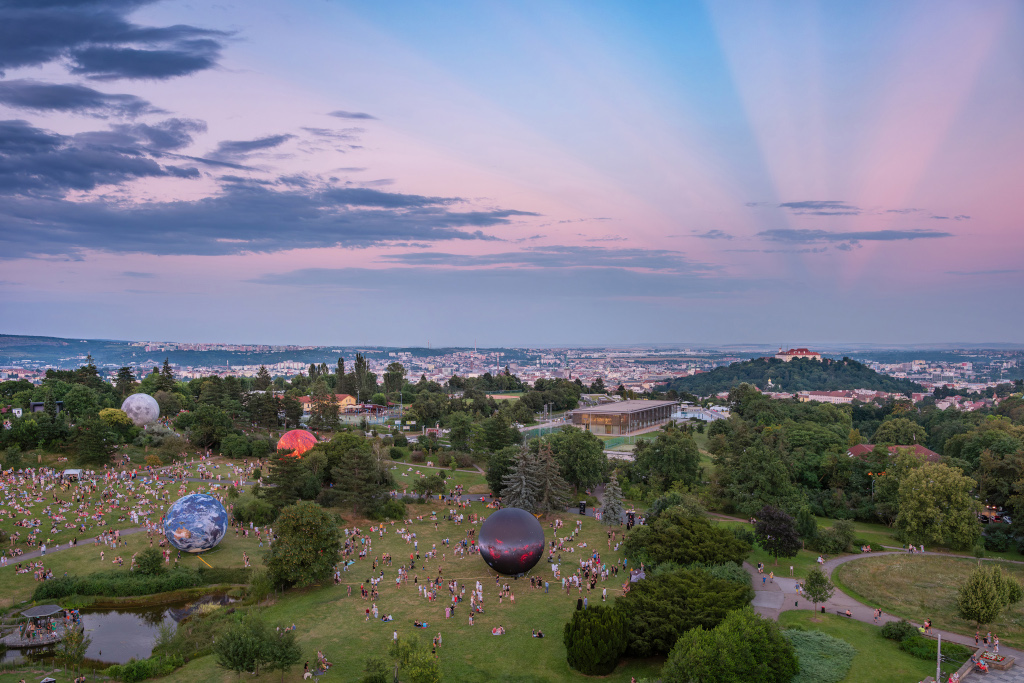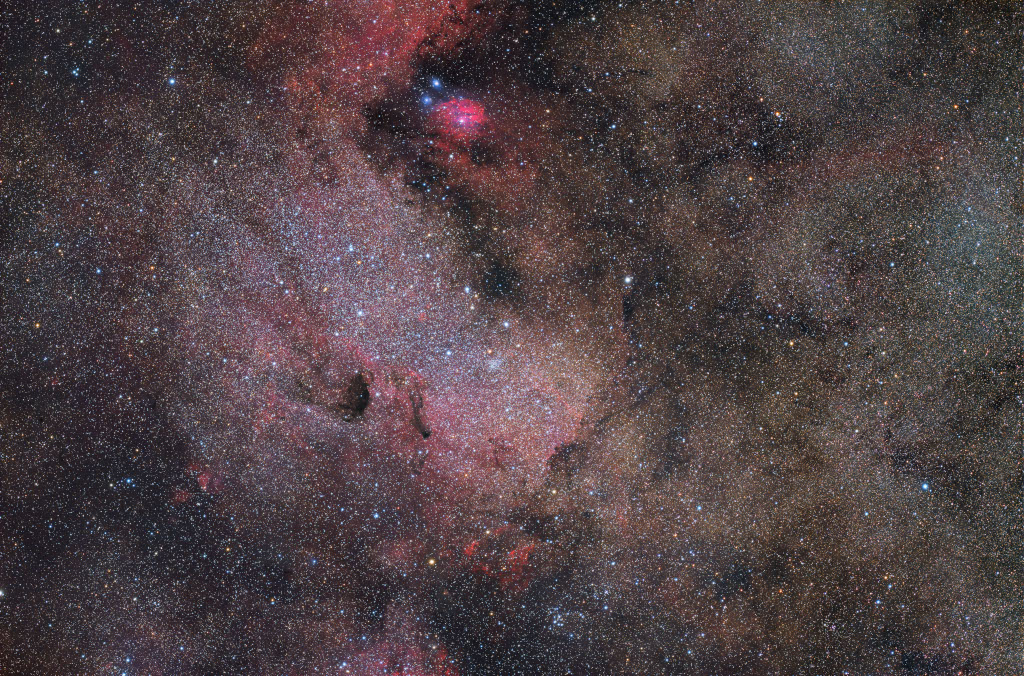Nombre total de pages vues
21/07/2024
INVENTIONS DE DEMAIN - Twitter par la pensée
ASTRONOMY - King of Wings Hoodoo under the Milky Way
2024 July 21
Image Credit & Copyright: Wayne Pinkston (LightCrafter Photography)
Explanation: This rock structure is not only surreal -- it's real. Perhaps the reason it's not more famous is that it is smaller than one might guess: the capstone rock overhangs only a few meters. Even so, the King of Wings outcrop, located in New Mexico, USA, is a fascinating example of an unusual type of rock structure called a hoodoo. Hoodoos may form when a layer of hard rock overlays a layer of eroding softer rock. Figuring out the details of incorporating this hoodoo into a night-sky photoshoot took over a year. Besides waiting for a suitably picturesque night behind a sky with few clouds, the foreground had to be artificially lit just right relative to the natural glow of the background. After much planning and waiting, the final shot, featured here, was taken in May 2016. Mimicking the horizontal bar, the background sky features the band of our Milky Way Galaxy stretching overhead.
20/07/2024
SANTé/MEDECINE - René-Théophile-Hyacinthe Laennec : inventeur du stéthoscope
ASTRONOMY - Apollo 11 Landing Panorama
2024 July 20
Image Credit: Neil Armstrong, Apollo 11, NASA
Explanation: Have you seen a panorama from another world lately? Assembled from high-resolution scans of the original film frames, this one sweeps across the magnificent desolation of the Apollo 11 landing site on the Moon's Sea of Tranquility. The images were taken 55 years ago by Neil Armstrong looking out his window on the Eagle Lunar Module shortly after the July 20, 1969 landing. The frame at the far left (AS11-37-5449) is the first picture taken by a person on another world. Thruster nozzles can be seen in the foreground on the left (toward the south), while at the right (west), the shadow of the Eagle is visible. For scale, the large, shallow crater on the right has a diameter of about 12 meters. Frames taken from the Lunar Module windows about an hour and a half after landing, before walking on the lunar surface, were intended to document the landing site in case an early departure was necessary.
19/07/2024
INVENTIONS DE DEMAIN - Le téléphone de fiston sur écoute
ASTRONOMY - Anticrepuscular Rays at the Planet Festival
2024 July 19
Image Credit & Copyright: Pavel Gabzdyl
Explanation: For some, these subtle bands of light and shadow stretched across the sky as the Sun set on July 11. Known as anticrepuscular rays, the bands are formed as a large cloud bank near the western horizon cast long shadows through the atmosphere at sunset. Due to the camera's perspective, the bands of light and shadow seem to converge toward the eastern (opposite) horizon at a point seen just above a 14th century hilltop castle near Brno, Czech Republic. In the foreground, denizens of planet Earth are enjoying the region's annual Planet Festival in the park below the Brno Observatory and Planetarium. And while crepuscular and anticrepuscular rays are a relatively common atmospheric phenomenon, this festival's 10 meter diameter inflatable spheres representing bodies of the Solar System are less often seen on planet Earth.
18/07/2024
ASTRONOMY - Messier 24: Sagittarius Star Cloud
2024 July 18
Image Credit & Copyright: Christopher Freeburn
Explanation: Unlike most entries in Charles Messier's famous catalog of deep sky objects, M24 is not a bright galaxy, star cluster, or nebula. It's a gap in nearby, obscuring interstellar dust clouds that allows a view of the distant stars in the Sagittarius spiral arm of our Milky Way galaxy. Direct your gaze through this gap with binoculars or small telescope and you are looking through a window over 300 light-years wide at stars some 10,000 light-years or more from Earth. Sometimes called the Small Sagittarius Star Cloud, M24's luminous stars are left of center in this gorgeous starscape. Covering over 6 degrees or the width of 12 full moons in the constellation Sagittarius, the telescopic field of view includes dark markings B92 and B93 near the center of M24, along with other clouds of dust and glowing nebulae toward the center of the Milky Way.
17/07/2024
SANTé/MEDECINE - Robert Koch découvreur du bacille de la tuberculose
ASTRONOMY - Villarrica Volcano Against the Sky
2024 July 17
Video Credit & Copyright: Gabriel Muñoz; Text: Natalia Lewandowska (SUNY Oswego)
Explanation: When Vulcan, the Roman god of fire, swings his blacksmith's hammer, the sky is lit on fire. A recent eruption of Chile's Villarrica volcano shows the delicate interplay between this fire -- actually glowing steam and ash from melted rock -- and the light from distant stars in our Milky Way galaxy and the Magellanic Clouds galaxies. In the featured timelapse video, the Earth rotates under the stars as Villarrica erupts. With about 1350 volcanoes, our planet Earth rivals Jupiter's moon Io as the most geologically active place in the Solar System. While both have magnificent beauty, the reasons for the existence of volcanoes on both worlds are different. Earth's volcanoes typically occur between slowly shifting outer shell plates, while Io's volcanoes are caused by gravitational flexing resulting from Jupiter's tidal gravitational pull.
LA TERRE VUE DU CIEL - L'Europe sous la neige
Cette image de l'Europe (de la Suède à l'Italie) recouverte de neige a été acquise par l'instrument Meris à bord du satellite EO...

-
2022 September 26 All the Water on Planet Earth Illustration Credit: Jack Cook, Adam Nieman, Woods Hole Oceanographic Institution ; Data ...
-
La majorité des grêlons qui tombent sous les orages et les averses ne pèsent que quelques grammes. Mais il y a quelques années, c'est un...








